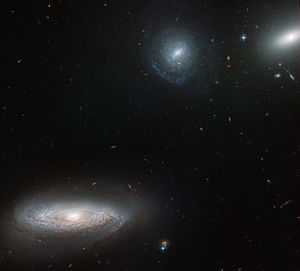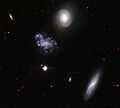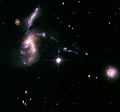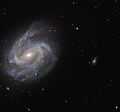Hickson Compact Group

A Hickson Compact Group (abbreviation: HCG) is a collection of galaxies designated as published by Paul Hickson in 1982.[2]
The most famous group on Hickson’s list of 100 objects is HCG 92, Stephan's Quintet.
According to Hickson: “Most compact groups contain a high fraction of galaxies having morphological or kinematical peculiarities, nuclear radio and infrared emission, and starburst or active galactic nuclei (AGN) activity. They contain large quantities of diffuse gas and are dynamically dominated by dark matter. They most likely form as subsystems within looser associations and evolve by gravitational processes. Strong galaxy interactions result and merging is expected to lead to the ultimate demise of the group. Compact groups are surprisingly numerous, and may play a significant role in galaxy evolution.”[3]
Gallery
-

Hickson Compact Group 59 by Hubble Space Telescope
-

HCG 31
-

The four members of HCG 44 by Hunter Wilson
- ^ "A fossil in the making". ESA/Hubble Picture of the Week. Retrieved 3 July 2014.
- ^ "A members-only galaxy club". ESA/Hubble Picture of the Week. Retrieved 10 December 2013.
See also
| Wikimedia Commons has media related to Hickson Compact Group. |
References
- ↑ "Crowded, but Suspiciously Quiet?". Picture of the Week. ESA/Hubble. Retrieved 10 August 2011.
- ↑ Hickson, Paul (1982). "Systematic properties of compact groups of galaxies". Astrophysical Journal 255: 382–391. Bibcode:1982ApJ...255..382H. doi:10.1086/159838.
- ↑ "Compact Groups of Galaxies". Retrieved 2006-10-23.
External links
- Astronomy Picture of the Day - Galaxy Group Hickson 31 - 22 February 2010


